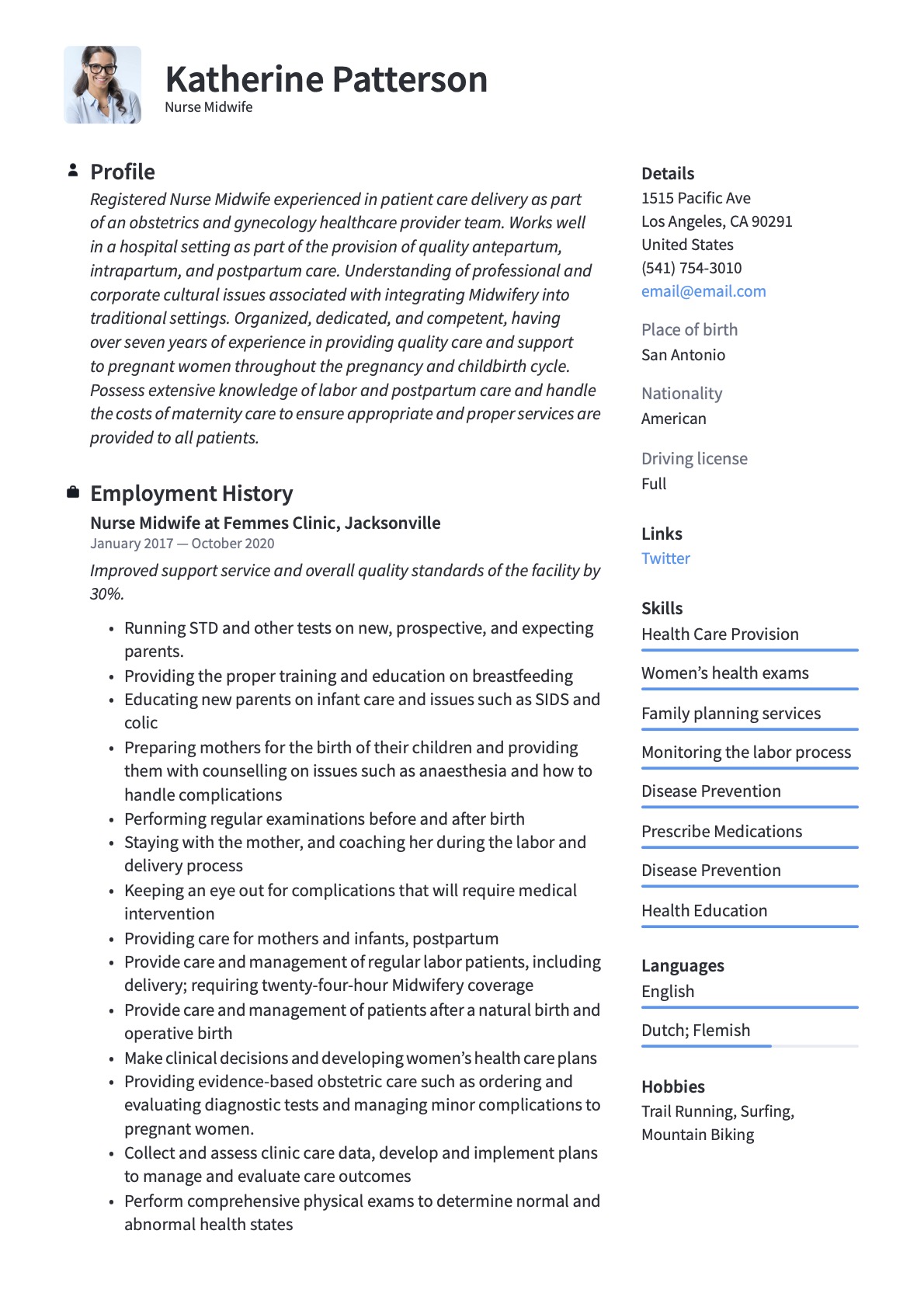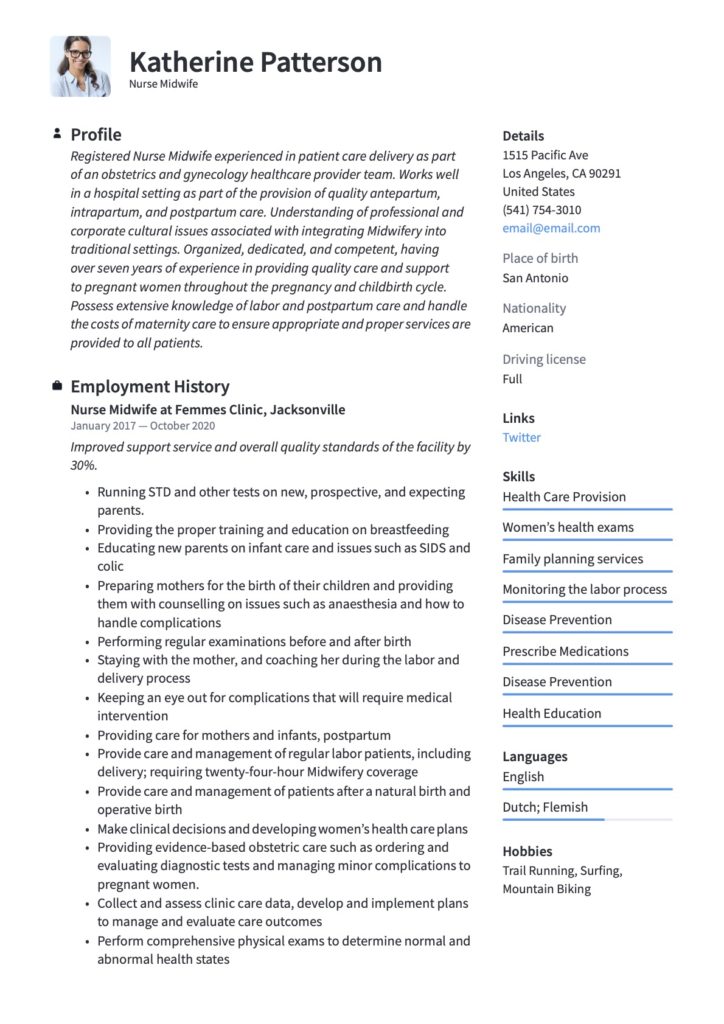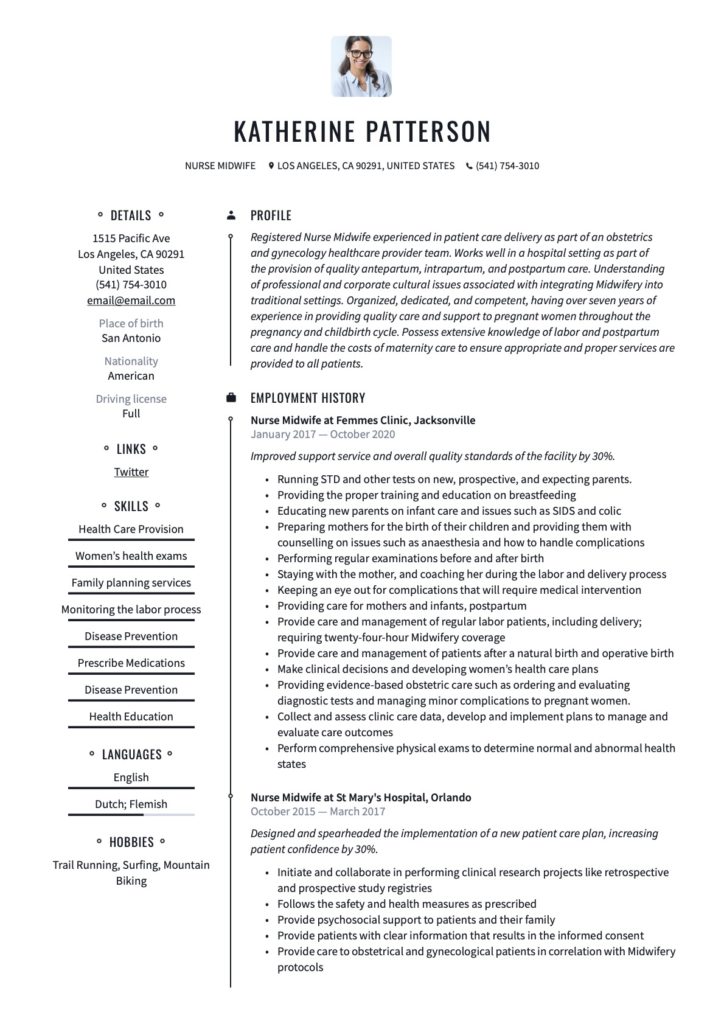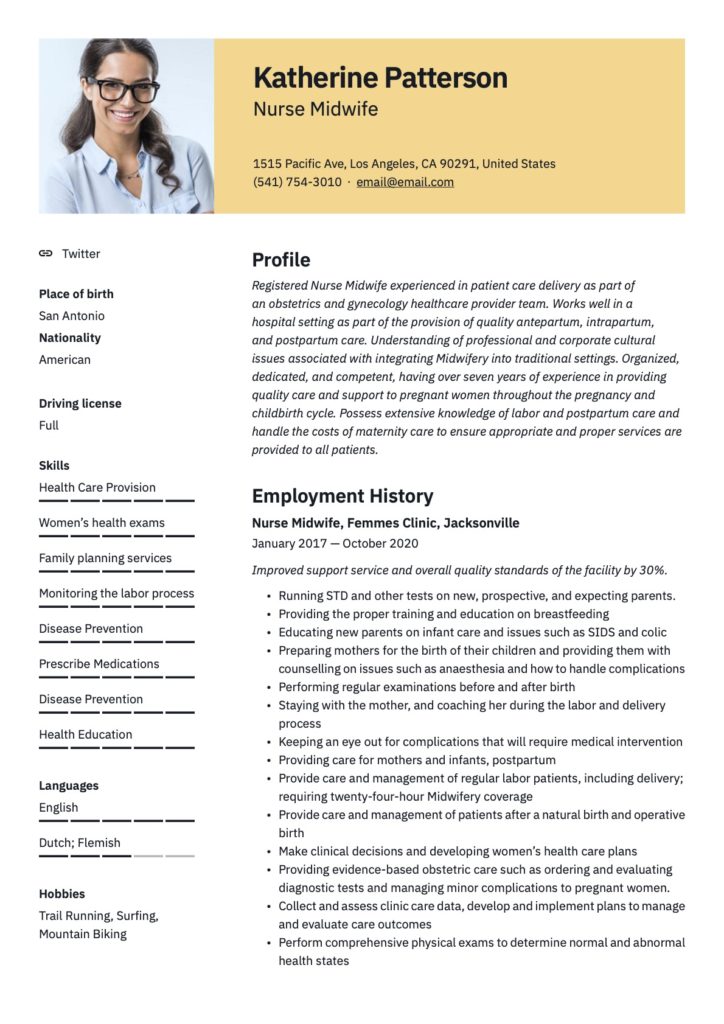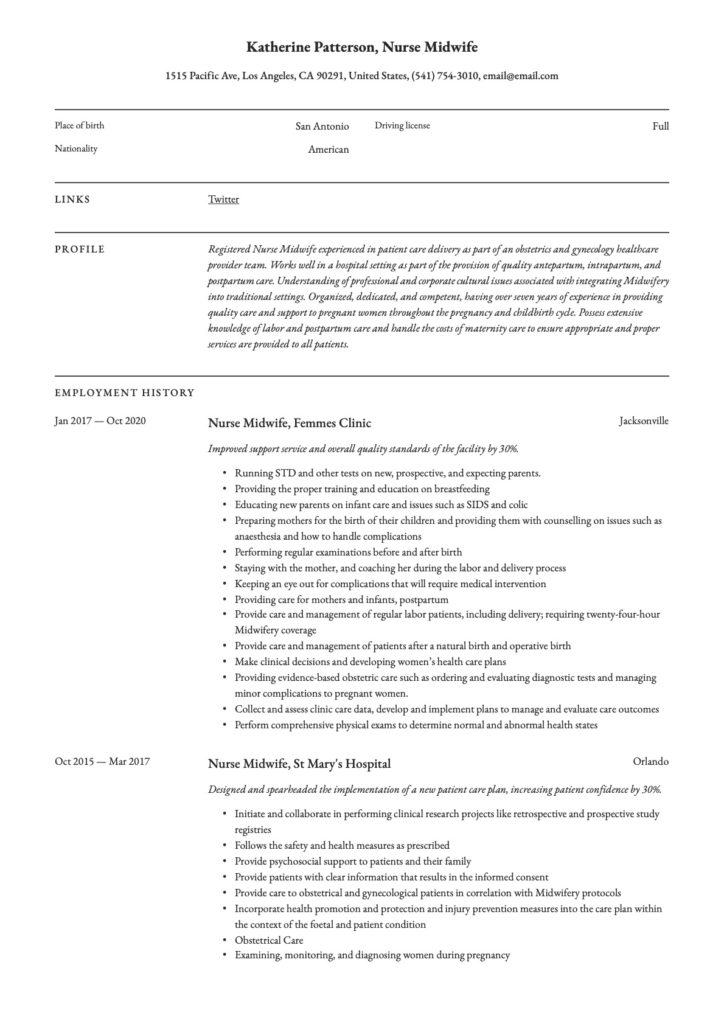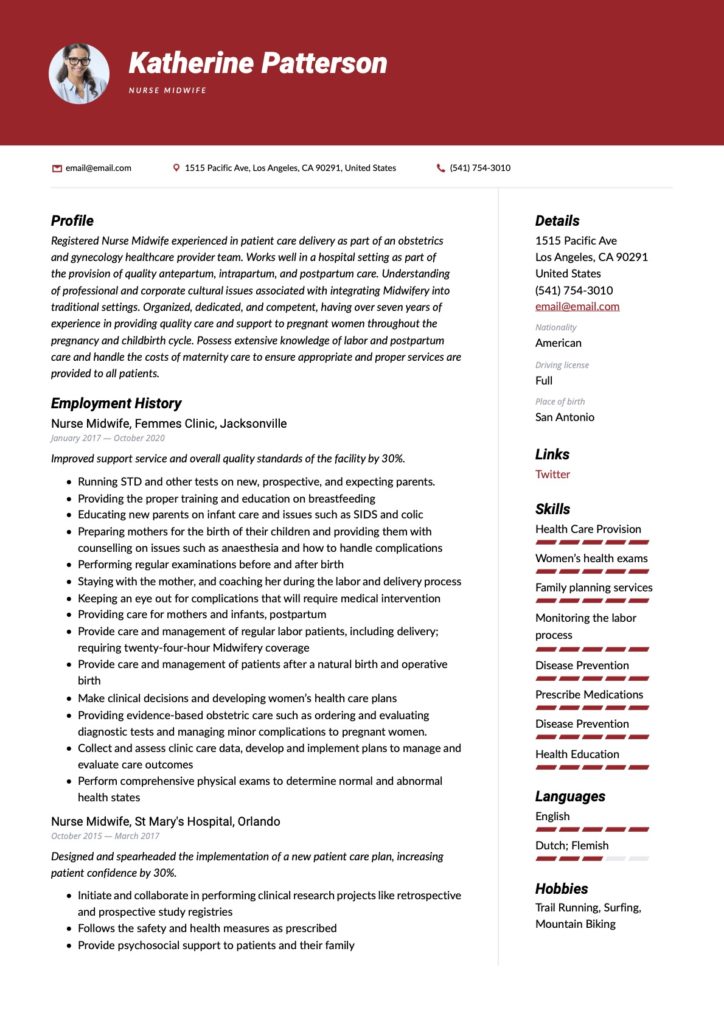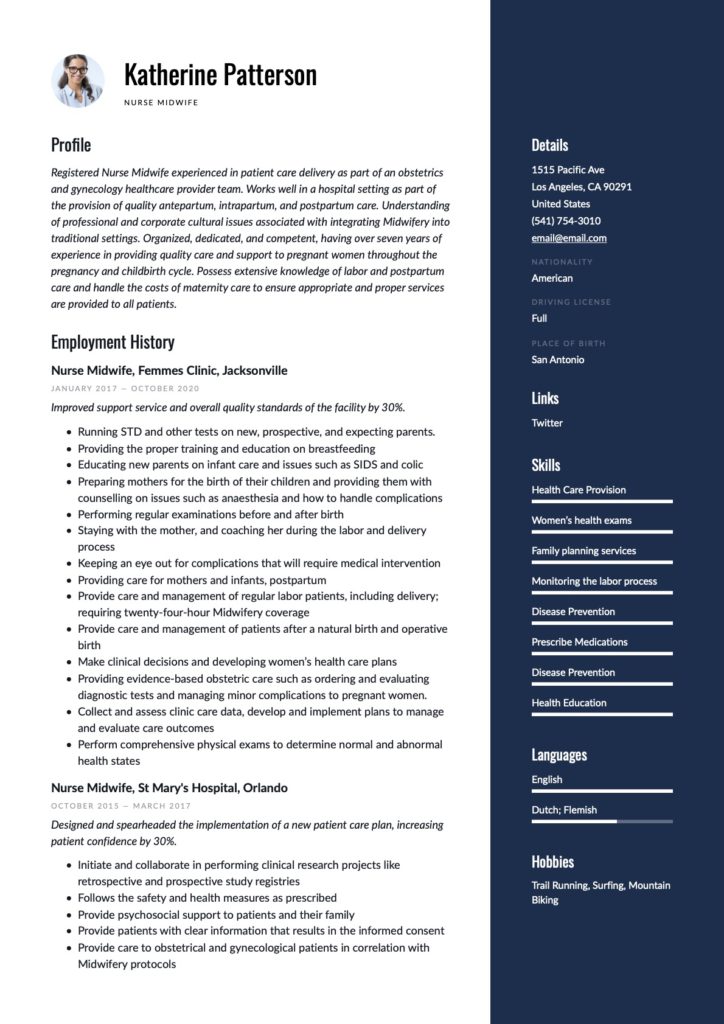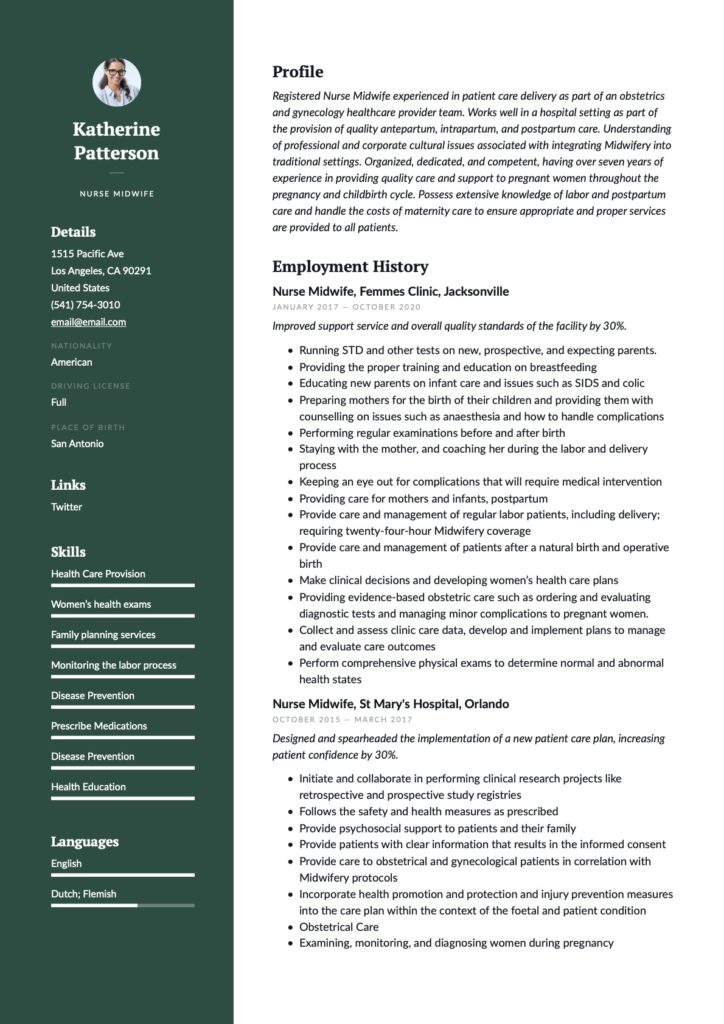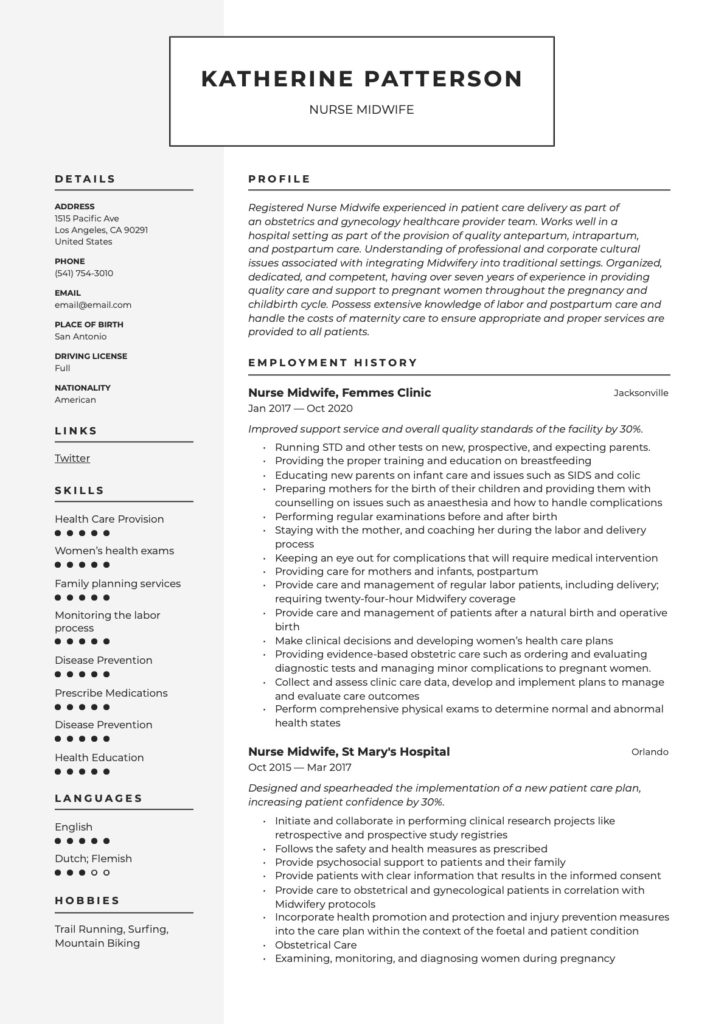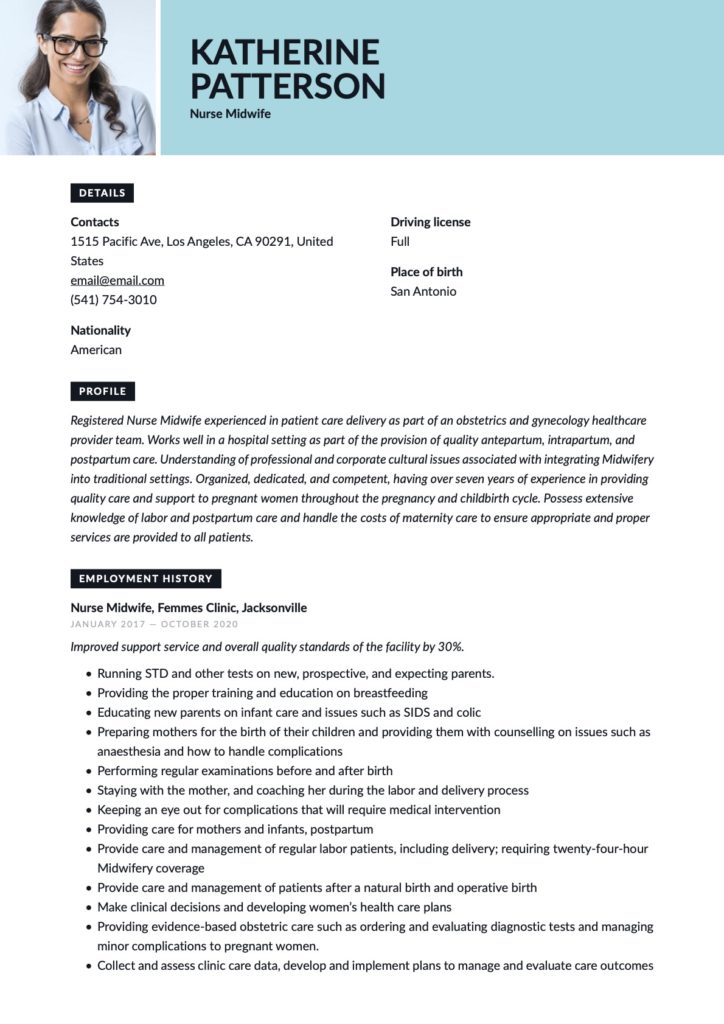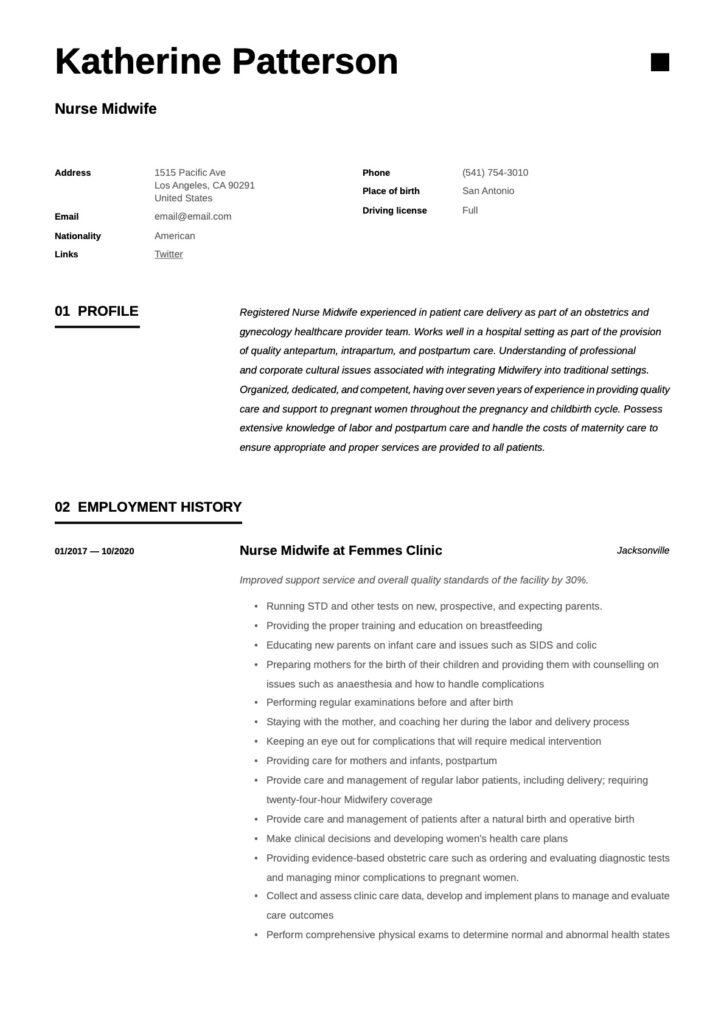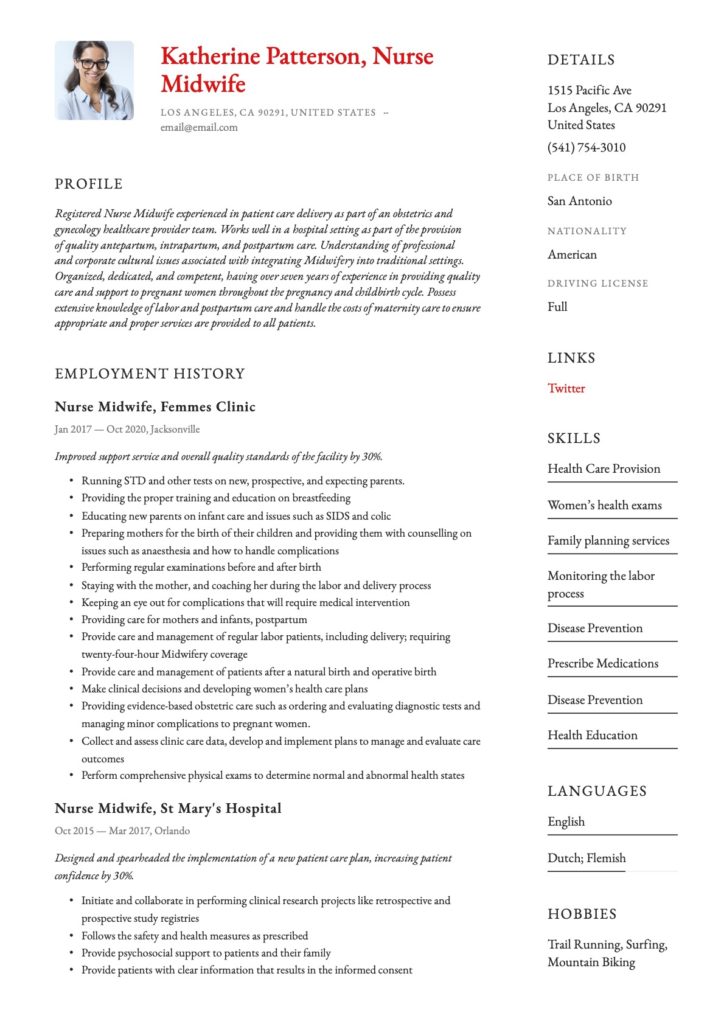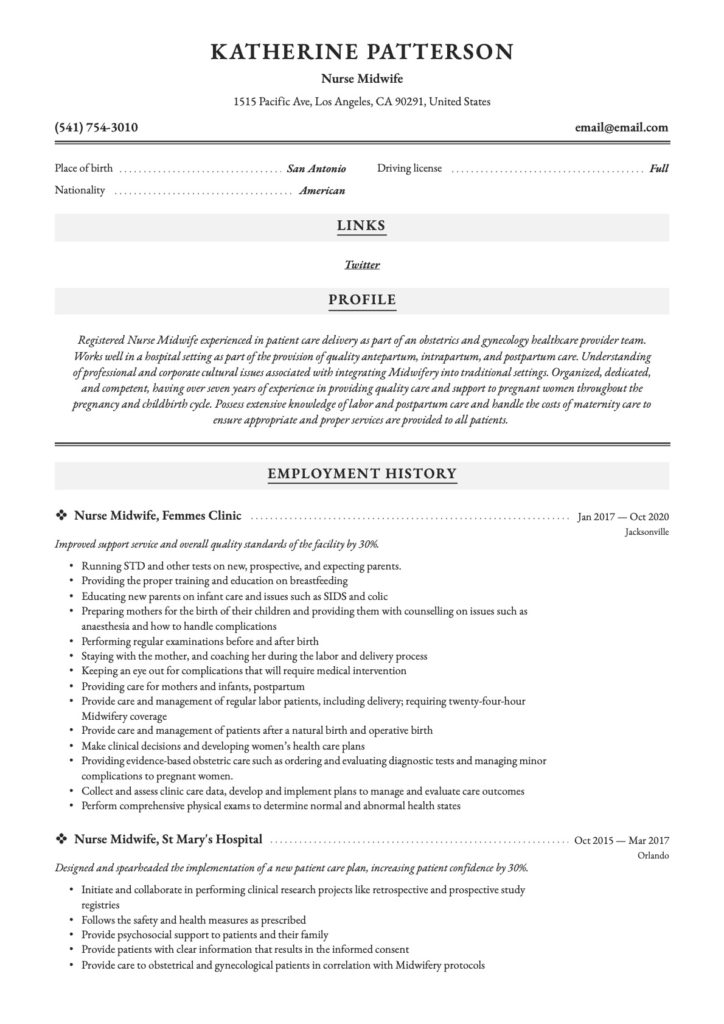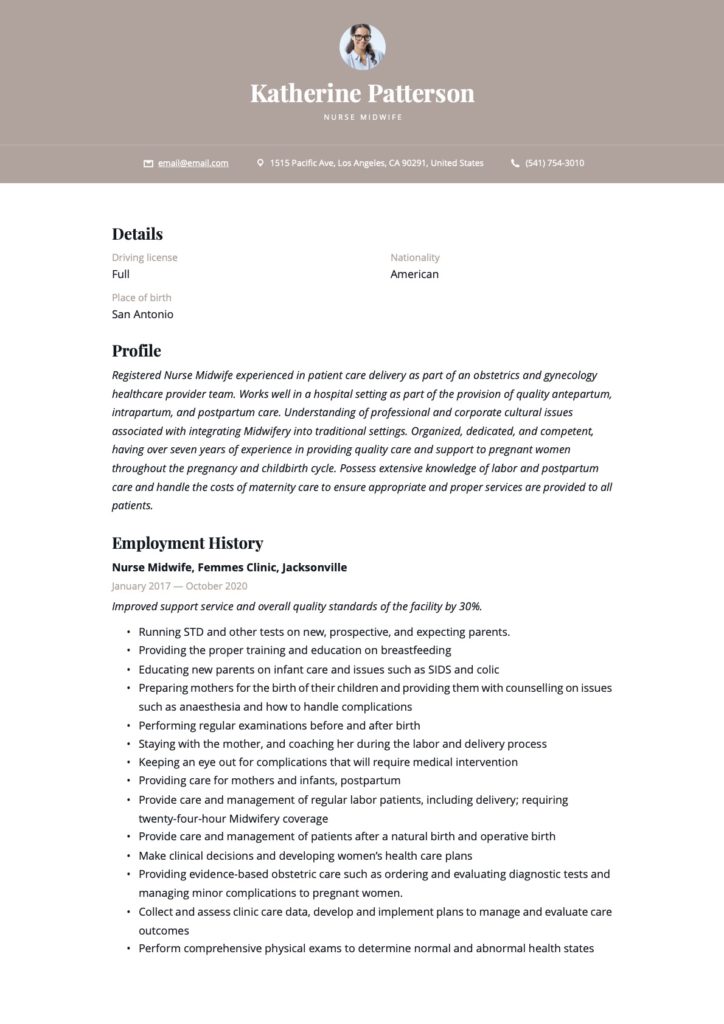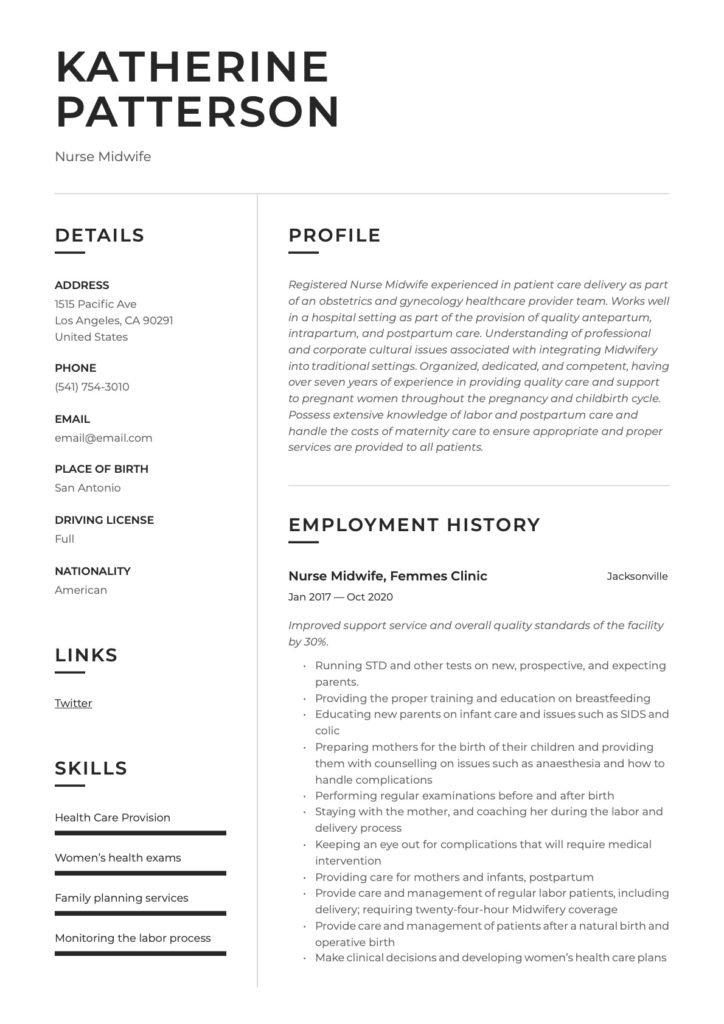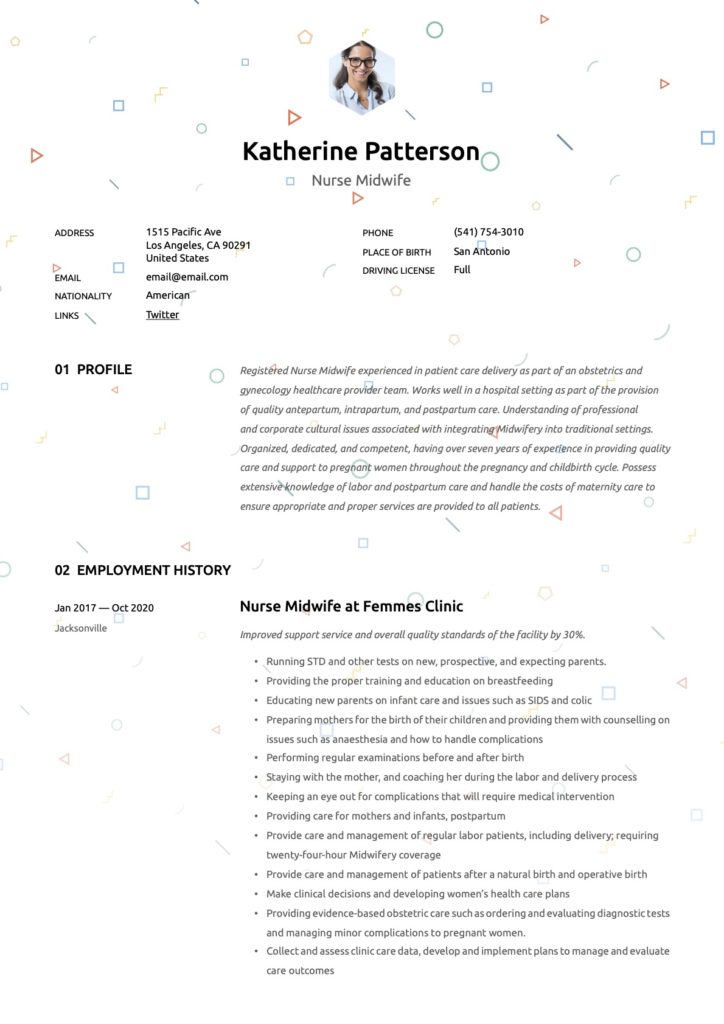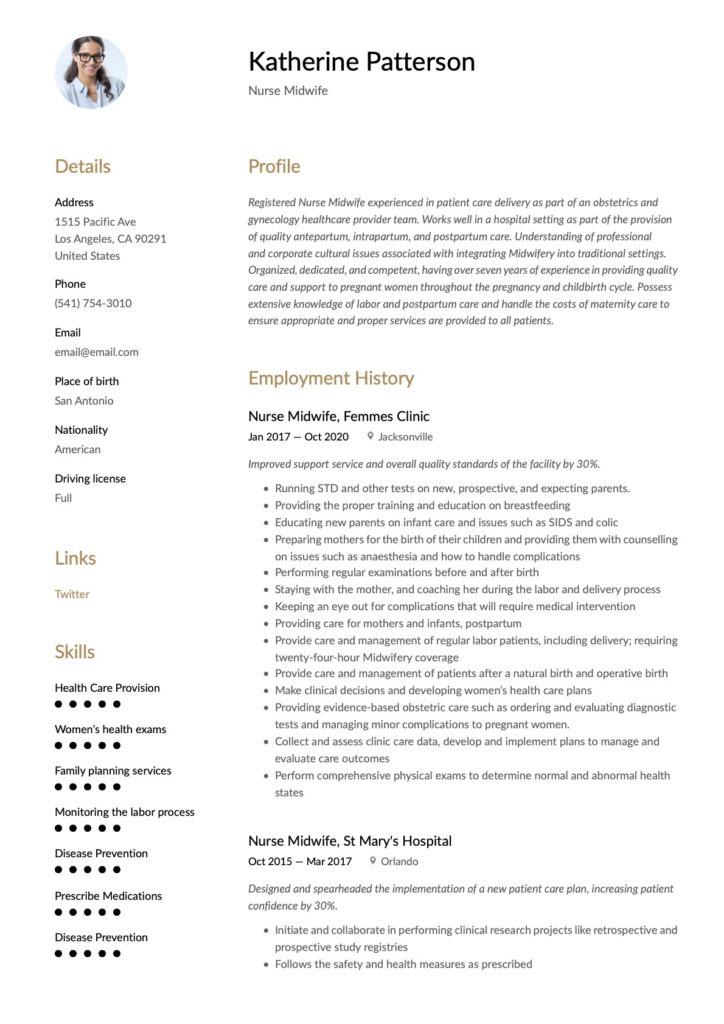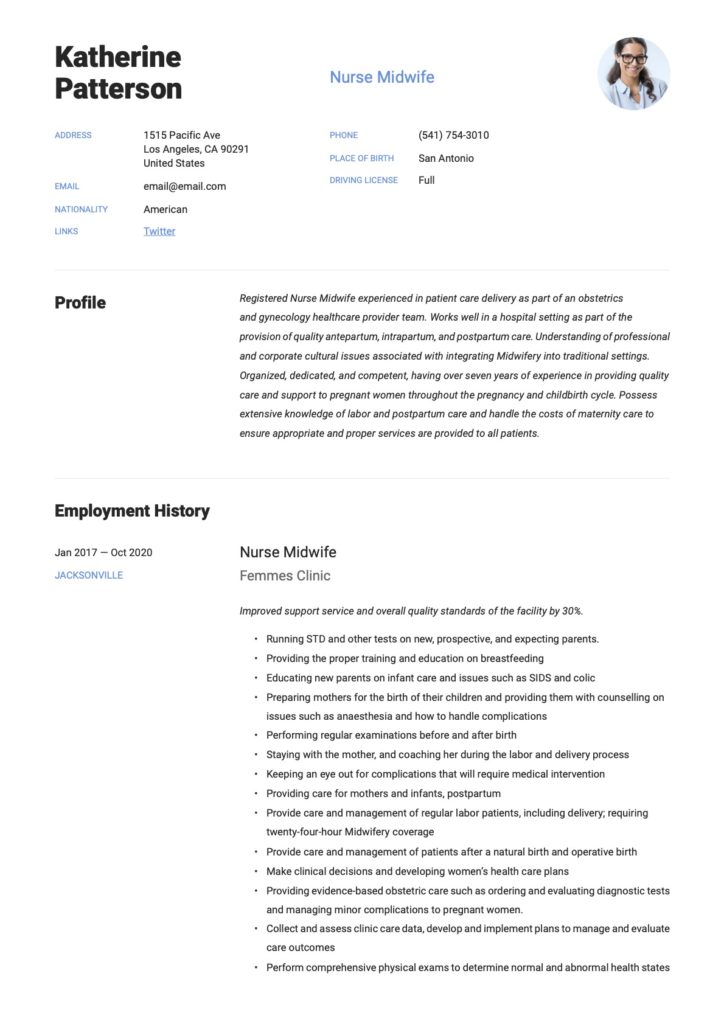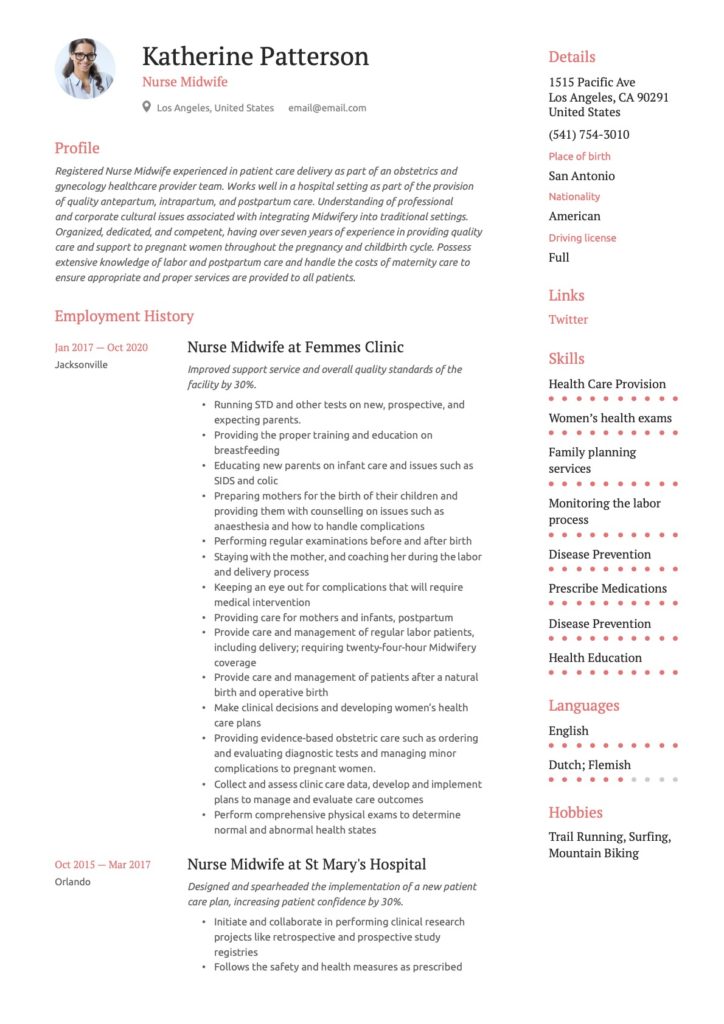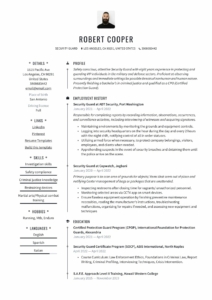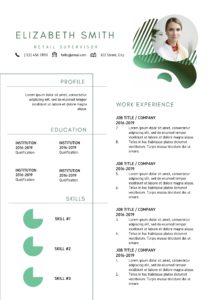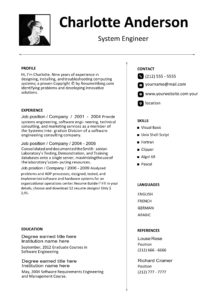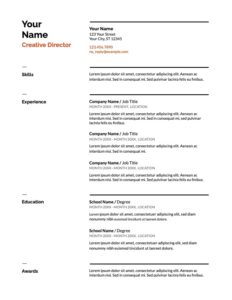Nothing is quite as rewarding as bringing a screaming little bundle of joy into the world. Midwifery is an ancient and traditional practice that is still in practice today. As a midwife, finding a job is about a lot more than mere passion. A midwife is a certified nurse specializing in pregnancy, labor, delivery, and postpartum care.
Your first challenge in the hunt for a job is to pass a hiring manager's stringent scrutiny. To land the position of your dreams, your Midwife (CNM) resume has to be stellar to fulfill any hopes of making it in the medical and health sector.
Fortunately for you, we have gone through the effort of finding all the information necessary to ensure you have a job-securing, interview-winning resume. In this article, you will find tips and tricks, guidelines, and all you need to know to waltz your way into your dream job without the generic “5 steps to creating the perfect resume” nonsense.
Review our guidelines for creating a Midwife Resume and CV below and grab the opportunity to wow your future employer with a fantastic application.
What you can read in this article
Midwife Resume Samples
(Free pdf resume sample downloads are at the bottom of this page)
Midwife Resume Writing Guide
Resume Sections
1. Contact Information:
At the top of your first page, list your first and last name, contact information such as cellphone number, and email address, as well as your address. If you have other professional platforms, such as a Facebook URL or linkedIn, it’ll be beneficial to include that information, too.
2. Career Summary:
This is the first impression that your mother always told you counts most. Your career summary should highlight your technical proficiency and should be proof of your academic credentials and working experience. Pro tip: tailor your career summary by using the verbs and key works stated in the job listing to fit the job better. Keep your summary short and sweet, much like your patients, by sticking to 3-5 points.
3. Qualifications Summary:
Becoming a Nurse Midwife requires more than your precious hopes and dreams. You need a Masters in the Science of Nursing (MSN). However, if you only have your Bachelor's or Associate’s degree, there are programs available that'll allow you to work towards that sorely needed MSN.
To enroll in for an MSN, you need to meet a few requirements:
- At least one year of working experience in a labor and delivery unit as a registered nurse.
- An unrestricted RN license
List the details of your qualification, including the date of commencement and completion, the name of your qualification, the institution from which you acquired it, and it’s location. You would also need to provide satisfactory GRE (Graduate record examination) scores. Nurse-midwives differ from certified midwives and direct-entry midwives in that their practices are based on advanced experience and education. As a nurse-midwife, you can also legally practice in all 50 states of the US and prescribe medication. As a nurse-midwife, you are considered a primary care provider under federal law.
4. Relevant Nursing Midwife Experience:
As a Nurse Midwife, you take on a range of responsibilities. Your job scope is much dependant on where you work. Working in private practice, for instance, would require you to take on more duties than you have in a large hospital. As a Certified Midwife, these tasks and responsibilities will typically include the appropriate responsibilities associated with your job in a healthcare setting regarding your experience. You will need to present your hiring manager with specific technical skills you have gained in a clinical setting during the practical portion of your course and any medical facilities you were previously employed at.
5. Skills Summary/Key Skills:
Use the technical skills mentioned in the job listing to correctly tailor your skills summary. This will ensure you are off to a running start and get you ahead of the other applicants. Keep your skills summary relevant and accurate, and mimic the phrases and words used in the job listing to really wow the hiring manager. This strategy will pack your resume with SEO keywords that the screening bots in the ATS system with pick up on. Your application has now been fast-tracked to round 2.
6. Licenses/Certifications/Relevant Coursework/Training:
If you hold the title of Registered Nurse, you will be required to hold a specific state license and certifications. The state you apply in may even require you as a CNM to be an advanced practice registered nurse (APRN), too. In addition to your traditional registered nurse training, you will also need to complete an accredited master’s degree through an accredited program. Depending on your current accreditation and qualification, there are a few available options you could follow to acquire just such a degree:
- RN-to-MSN programs: for Nurses currently holding an Associate’s degree, a bridge program may fast-track you to your MSN degree.
- Direct entry programs: If you hold a Bachelor’s Degree in a non-nursing field, you could potentially earn your MSN through programs focusing on people hoping to change careers.
- MSN programs: So, you already have a BSN, which means you can look at MSN programs available in your area or online. Your classes will thus include Advanced Nursing, prepartum and postpartum, and other subject relating to women’s health
- Doctorate programs: this is a relatively new option, but well worth pursuing if you’re hoping to advance your career. This degree enables you to assume a leadership role in nurse-Midwifery.
A nurse-midwife is required to have passed industry prep exams and prep programs. For the industry “newborns,” state-approved internships are also a requirement. Include all your courses and programs, along with licensing and accreditations you’ve obtained. Include the dates on which you completed them, the level at which you passed, the institution you attended, and your member identification information.
What to Highlight in a Midwife Resume
More and more parents are opting for the service of a Midwife nurse alongside an OB-GYN. Some even choose to have a just a Midwife assisting with the birthing process. A Nurse Midwife's role is comprehensive and be a challenging task to sketch a complete picture of your life’s worth of Midwifery-related experiences in a mere 1-2 page resume. We went ahead for you and compacted a few crucial competencies, histories, and qualifications that hiring managers may be looking out for in candidates.
First, make mention of your work environment. A Certified Nurse-Midwife will be in charge of providing reproductive care. You will also provide maintenance and counseling during the child’s infancy. As a certified nurse-midwife, you will often find placement in hospitals, birthing centers, private practices, or more extensive health care organizations. One nurse-midwife may work at a variety of these throughout his/her professional career. Be clear about your current and previous work settings, also explaining to employers what your hours are like in terms of shifts and availability during weekends.
Second, provide your hiring manager with a short description with regard to your classification and specialty. Consulting a midwife is just one of many options available to soon-to-be parents for pre and postnatal care. There are subcategories withing the Nurse-Midwife industry and you should explain the scope of your specialty to recruiters:
- OB-GYNs Nursing Assistants:
specialize in obstetrics and gynecology; OB-GYNs are physicians that handle non-traditional births and provide care such as the induction of labor or performing C-sections in some cases. They are also able to deliver babies in complicated pregnancies.
- Doulas:
Doulas are professionals who’ve obtained certification through programs focusing on the birthing process and pre-natal and postnatal care. Unlike a nurse-midwife, the care they provide is not medical but rather emotional and physical. They aim to create a calm environment for the mother and family during labor for a more effective birthing experience. They also serve as the point of contact between the patients and medical practitioners. - Childbirth Educators:
They lead classes that focus on providing parents with information and counselling. They don’t take part in the actual birthing process, but they do also work in hospitals or birthing centres. - Other Specialists:
Many fields aim and specialize in safe and healthy birthing experiences and provide pre and postnatal care. Some of these roles include lactation support, postpartum physical therapy, pre-natal fitness instruction, and new parents' counsellors.
Next up , present your your daily tasks and activities. You can generalize what a typical day (or night) in a midwife's life looks like. Including specific times, schedules, and the frequencies of practices, checks, and procedures. According to the American College of Nurse-Midwives, nurse-Midwifery encompasses a range of primary women’s health care services. These cares range from adolescence to menopause. As a CNM, you are licensed to provide the following core services:
| Primary care | Gynaecologic care |
| Family planning services | Preconception care |
| Care during pregnancy | Care during childbirth and the postpartum period |
| Care of the average newborn during the first 28 days of life | Treatment of male partners for sexually transmitted diseases |
Finish off with some technical jargon to get the attention of your future employers and hiring managers. Include things such as the tu]ypes of medications you’re allowed to administer and devices you can use, such as blood pressure monitors, thermometers, forceps, lancets, syringes, etc.
Include the following details
- The various locations you are registered to practice in
- Your GPA score provided it’s above 3.5
- Volunteer work in medical or healthcare fields such as outreaches, rural clinics, blood drives, field hospitals, etc.
- Where you completed your practical placements while in nursing school.
- Make sure to mention facilities, dates, and hours accumulated.
- Hours worked and all clinical rotations
Midwife Resume Objective
Your resume objective (also known as career objective) is essential because it focuses attention on your academic tenure, core competencies, and interpersonal skills. It’s an introduction to your application. Use keywords from the job listing to tailor your resume to impress your hiring manager best. The goal and motive of a resume objective are to present your future employer with the value you would add to the institution or team you will be working alongside. Tell them about your excellent technical proficiency and interpersonal skills, and stick to using short sentences packed with those keywords. For a clean and neat-looking resume, opt for using bullet points to state 3-5 meaningful experiences
Your career synopsis may include the following aspects:
- Relevant years of experience and specialty
- State improvements and proficiencies and your technical value-added
- Your highest credentials and qualifications
- Your attributes that make the best fit for the job
- Professional achievements, accolades, and awards
Keep it short, sweet, and easy to read. Again, use those keywords when representing your experience to prove you are fit for the job.
Example Resume & Career Objectives:
Objective Example 1:
“Registered Midwife experienced in patient care delivery as part of an obstetrics and gynecology healthcare provider team. Works well in a hospital setting as part of the provision of quality antepartum, intrapartum, and postpartum care. Understanding of professional and corporate cultural issues associated with integrating Midwifery into traditional settings. Organized, dedicated, and competent ‘Midwife' having over seven years of experience in providing quality care and support to pregnant women throughout the pregnancy and childbirth cycle. Possess extensive knowledge of labor and postpartum care and handle the costs of maternity care to ensure appropriate and proper services are provided to all patients. Excellent interpersonal skills and the ability to work with the team.“
Objective Example 1:
“Highly trained and sensitive Nurse Midwife RN with an incomparable record of providing stellar medical and emotional care and services to pregnant patients. Able to work in high-pressure environments. Flexible availability to accommodate unpredictable patient and physician schedules as needed.“
Objective Example 1:
“Deadline-driven, highly trained, and sensitive Midwife Nurse with a stellar record for providing exceptional medical and emotional care to pregnant patients. Adept at performing in a high-pressure work environment. Flexible work availability to accommodate patient and physician schedules as needed.“
Midwife Job Descriptions, Responsibilities, and Duties
A nurse-midwife resume is expected to have specific foundational proficiencies and technical duties. Luckily, we have compiled a list of some examples the hospital administrator, Principal, or Health Center’s Shareholder’s Board may find most appealing. Be sure to customize, incorporate, and align those relevant to your previous working experience into your resume.
Examples
A Midwife's job description may be:
- Running STD and other tests on new, prospective, and expecting parents.
- Providing the proper training and education on breastfeeding
- Educating new parents on infant care and issues such as SIDS and colic
- Preparing mothers for the birth of their children and providing them with counseling on issues such as anesthesia and how to handle complications
- Staying with the mother, and coaching her during the labor and delivery process
- Keeping an eye out for complications that will require medical intervention
- Providing care for mothers and infants, postpartum
- Provide care and management of regular labor patients, including delivery; requiring twenty-four-hour Midwifery coverage
- Provide care and management of patients after a natural birth and operative birth
- Making clinical decisions and developing women’s health care plans
- Providing evidence-based obstetric care, such as ordering and evaluating diagnostic tests and managing minor complications to pregnant women.
- Perform comprehensive physical exams to determine normal and abnormal health states
- Initiate and collaborate in performing clinical research projects like retrospective and prospective study registries
- Follows the safety and health measures as prescribed
- Provide psychosocial support to patients and their family
- Provide patients with clear information that results in the informed consent
- Provide care to obstetrical and gynecological patients in correlation with Midwifery protocols
- Incorporate health promotion and protection and injury prevention measures into the care plan within the context of the fetal and patient condition
- Obstetrical Care
- Examining, monitoring, and diagnosing women during pregnancy
- Evaluating and developing care programs for patients
- Providing full care antepartum, including laboratory tests in the hospital, home, and community.
- Monitoring fetal and maternal health during pregnancy
- Referring high-risk patients to doctors and other specialists for specialized care
- Providing health and parenting education
- Offering counseling, advice, and support during events such as termination, miscarriage, stillbirth, neonatal death, and abnormalities.
- Assisting and supervising mothers during childbirth and fetal monitoring.
- Providing care postpartum
- Giving advice and support about the daily care of the infant
- Providing breastfeeding support
- Provide routine gynecological care to your patients
- Performing annual health examinations
- Ordering tests and prescribing medications such as birth control
- Providing family planning services and counseling
- Providing counseling and care for women experiencing menopause
Highlight Your Accomplishments
Resumes that showcase technical accolades and professional achievements are granted the most attention from hiring managers. That being said, this achievement sections not a tribute and memoir of your life from birth. Stick to selling the relevant experience you’ve obtained in the mast, 3-5 years. It is also highly advisable that you make use of bullet points for a quick and easy read.
Also, remember to add a numerical value, such as we have done below. Numbers are proof of your proficiency. Again, try to answer some of the questions listed below into your list of accomplishments:
How many patients in your ward were in your care?
How many hours did you accumulate for each rotation cycle?
What was the hospital’s patient capacity?
How long do you need to administer an IV?
Pick your top 3–5 accomplishments you feel set you apart from the rest and run with them. Include powerful action verbs to give your statements that little extra push.
Accomplishment Statement Examples:
- Improved support service and overall quality standards of the facility by 30%.
- Supervised multiple groups of Nurses both in the ER and Oncology between the years 2012 and 2019.
- Corresponded appropriate information to patients, peers, managers, and physicians, consequently decreasing the communication gap by 50%.
- Designed and spearheaded the implementation of a new patient care plan, increasing patient confidence by 30%.
- Improved support service level by 25% through passion and commitment.
Midwife Education Section Example
Education isn’t merely a list of past qualifications. Along with your qualifications, GPA, and SAT scores, provide details regarding your Midwifery Nursing-relevant credentials and hours of experience during your clinical rotations. Also, include advanced certifications and courses related to your specialty if you are specializing in a field. After your degree, your next step towards success will be to acquire accreditation in the Midwifery specialty by taking (and passing) the AMCB (American Midwifery certification board) exam.
The format you need to use to list your qualifications is not quite as tricky: list the Date Completed, Name of Qualification, Institution you Attended, and location. Add your GPA Scores, Major Subjects, or Hours of experience you’ve accumulated in the form of bullet points
A Midwife’s education section example:
2018 – Current Master of Science in Nursing, University of Miami Miller School of Medicine, Miami, FL
2017 – Acute Care Nursing Practitioner Certificate, Grand Canyon University, Springfield, Arizona
Subjects: Health Care Quality, Patient Safety, Health Informatics, Nursing Education, Nurse Leadership, and Public Health Nursing
2012 – 2014 Bachelor's Degree in Nursing, Joliet University, Chicago, IL
2011 – Certified Midwife, American Midwifery Certification Board, Miami FL
2010 – Advanced Practice Nursing Certificate, American Midwifery Certification, Miami, FL
Skills for your Midwife Resume
Nurse-Midwifery is a sensitive job that is, therefore, a calling more than a vocation. As a Nurse-Midwife, you need to possess the appropriate abilities and personality traits to turn your job into a success. Every year, hiring managers look at countless resumes and often skip straight to the skills section without giving the rest of your resume so much as a second thought. Your skills section needs to be accurate but also memorable. Make your skills section noteworthy and unique.
To adhere to the length constraints of a resume, usually 1 – 2 pages, opt for using a Skills Matrix approach, as we have used to list the prima donnas of skills a nurse-midwife should have.
Interpersonal Traits
| Caring | Trustworthy |
| Compassionate | Empathetic |
| Friendly | Calm under pressure |
| Approachable | Confident |
| Meticulous | Resilient |
| Honest | Adaptable |
| Patient | Resourceful |
| Supportive | Punctual |
Technical Competencies
| Physical Examinations | Laboratory and Diagnostic tests |
| Monitoring the labor process | Evidence-based Alternative and Complementary Therapies |
| Obstetrics | Care Continuity |
| Clinical Rotations | Health Education |
| Checking Vitals | Disease Prevention |
| Disease Prevention | Neo-Natal Care |
| Facilitating the health family and interpersonal relationships | Prescribe Medications |
| Contraceptives and Controlled Substances | Admitting, Managing, and Discharging Patients |
| Primary Care | Gynaecologic and Family Planning Services |
| Preconception Care | Pre-Natal Care |
| Childbirth and the Postpartum Period | Care of the normal new-born during the first 28 days of life |
| Handle Birth Complications | Monitor Physiological and Developmental Processes Post-Birth |
Qualifications/Certifications associated with Nurse-Midwives
| Bachelor of Science Degree in Nursing (BSN) | Registered Nurse (RN) | Certified Nurse Midwife (CNM) |
| Nurse Practitioner (NP) | Clinical Nurse Specialist (CNS | Certified Nurse Midwife (CNM) |
| Certified Registered Nurse Anesthetist (CRNA) | Licensed Practical Nurse (LPN) | Certified Nurse Midwife (CNM) |
| Associate's Degree in Nursing (ADN) | Certified Registered Nurse Anesthetist (CRNA) | National Council Licensure Examination (NCLEX-RN) |
Professional information on Nurse-Midwives
Sectors: Medical, Clinical, Hospital, Midwifery, Gynecology, Obstetrics, Hospital, Healthcare,
Career Type: Infant Care, Female Healthcare, Professional Care, Specialized Care, General Care, Post Op Recovery, Preventative Care, Health Education,
Person type: Medical Professional, Advisor, Counselor, Educator, NurseCaregiver, Helper, First Responder,
Education levels: Bachelor’s Degree and upwards
Salary indication: Range typically falls between $102,034 and $125,739 (Betternurse.org)
Labor market: Estimated 45% from 2019 – 2029 (Bureau of Labor Statistics)
Organizations: Hospitals, Homes & Residences, Private Clinics, Military, Hospices, Schools, Private Practices, Semi-Private Birth Facilities, Medical Facilities,
